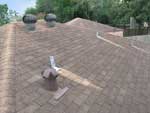Hail Damage Facts & Misconceptions
Figure 1 |
Figure 2 |
Figure 3 |
|||||||
Click on Photo above to enlarge
1. The reported size of the hail is not necessarily the largest that fell.
Hailstorms are not limited to one size stone. For every hundred smaller stones that fall and "pepper" a roof there might be several larger stones that fall among them. Finding the impact marks of these larger stones can be a painstaking task for even the most experienced inspector. Aggravating this task are factors such as the height of the roof, how steep the roof is, how hot it is on the roof, etc.
1. The white spots that pepper a hail impacted roof are not necessarily damage (See figure 1).
Several years after a roof has been installed it will begin to collect a light coating of algae that typically covers the entirety of the roof causing it to become a slight shade darker than when it was new. Hailstones impacting a roof coated with this algae leave a "clean spot" where the algae had been thereby causing the "peppered" look over the body of the roof that most homeowners associate with being hail damage. This is not necessarily correct.
Many roofs with this "peppered" effect are not damaged at all, as small hail incapable of causing real damage will still leave this clean spot. However, one must survey these spots with scrutiny because hidden among these smaller spots are larger impacts that have caused real damage.
3. A roof with out the "Peppered" look can still be damaged (See figure 2 & 3).
Roofs that haven't been in place long enough to be stained by the algae will obviously not show the "Peppering" as there is no algae to be removed. Brand new roofs are very susceptible to damage by hail as seen Figures 2 & 3. Note that the damaged area is black. Many composition roofs are darker in color causing the location of these damaged areas to blend in with the roof. In Figure 2 it is difficult to see the damage even while on the roof. A close up view as shown in Figure 3 is necessary.
In most cases, hail damage can not be surveyed from the ground. A slow, shingle by shingle inspection on the roof is typically necessary for an accurate survey.


